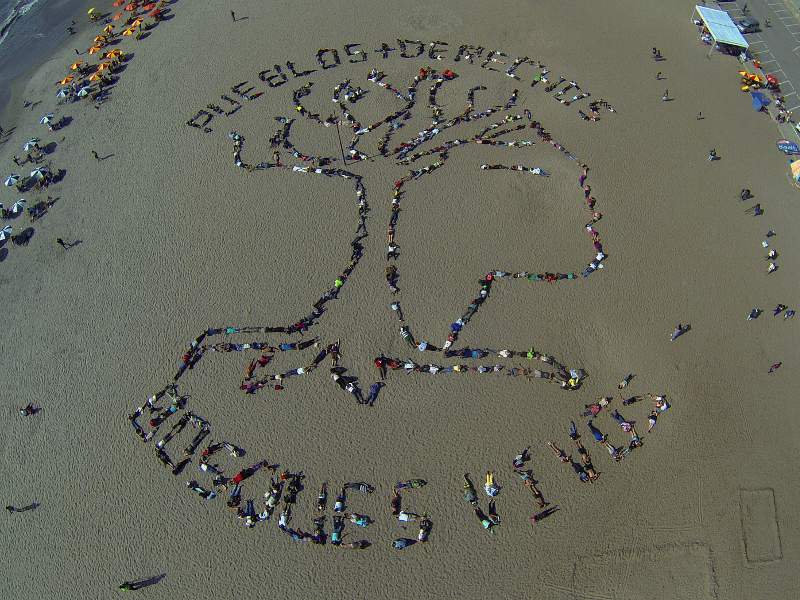Additional photos & video available upon request.
Descargar versión en español
Lima, Peru – Indigenous territorial rights must be guaranteed as an effective strategy to address climate change was the message of an enormous “human banner” image created on Agua Dulce beach today outside the UN COP20 climate summit. Hundreds of indigenous peoples and their allies used their bodies to vividly display the words “Pueblos + Derechos = Bosques Vivos” (Peoples + Rights = Living Forests).
“Together we created a beautiful image of what we want to see in the world. We want our rights and territories respected, here in Peru, across the Amazon and around the world,” said Juan Agustín Fernandez, leader of the Shipibo community of Cantagallo who actively participated in the creation of today’s banner.
Representatives from the following Amazonian peoples participated in the creation of the banner: Shipibo, Asháninka, Achuar, Awajún, Munduruku, Guajajara, Kichwa and Kampupiyawi.
In the context of the COP20 climate summit, indigenous peoples from Peru, the Amazon, and around the world are advocating for a rights-based approach to dealing with the climate crisis. Not only are indigenous people some of the most affected communities, but they are also important leaders in the search for real and lasting solutions.
“Where the territorial rights of indigenous peoples are respected, greenhouse gas emissions from deforestation is reduced. We demand territorial recognition of 20 million hectares in the Peruvian Amazon to ensure legal security for our people. This territory should be for the community,” said Achuar indigenous leader Henderson Rengifo, member of AIDESEP National Steering Committee. His comments mirrored recent studies that show lower deforestation rates in rainforest areas under the effective management of indigenous and other local communities.
The message for the human banner design included the term “Living Forest,” which refers to a holistic indigenous concept towards the Amazonian environment and is a perspective often overlooked when discussing solutions to climate change. Primary rainforest sequesters carbon yet beyond that, its biodiversity provides life for the ecosystems and the people who live within it. In the spiritual realm, according to this perspective, the forest is alive with the spirits of ancestors and animals. A Living Forest is one in which indigenous peoples are free to choose their way of life and to defend their territories as they see fit.
The recent WRI/RRI report concluded that, “When indigenous peoples and local communities have no or weak legal rights, their forests tend to be vulnerable to deforestation and thus become a source of CO2 emissions.” Conversely, “Legal forest rights for communities and government protection of their rights tend to lower carbon dioxide emissions and deforestation.”
Due to the advocacy of indigenous federations, indigenous peoples have a much higher profile within the COP20 in Lima than in past summits. The Indigenous Pavilion is a central manifestation of that presence. But beyond words and discourse, the tangible policy impact of this advancement remains to be seen. The human banner is designed to complement the extensive efforts indigenous peoples are making both inside and outside the official COP venue to bring awareness to the importance of officially obtaining recognition and rights to their ancestral territories.
This is the first time the annual United Nations Framework Convention on Climate Change Conference of Parties (UNFCCC COP20) has been held in an Amazon country. Given that some 72% of Peru’s national territory is within the Amazon Basin, COP20 presents a rare opportunity to generate greater awareness and support about the critical importance of the Amazon rainforest in maintaining and stabilizing our global climate and the key contribution indigenous peoples’ stewardship of their territories makes in protecting this critical organ of the earth’s life support system. Humanity’s survival depends on not burning two-thirds of our global oil reserves which can only be achieved by limiting fossil fuel extraction. Indigenous people are calling to keep the oil in the ground starting with the biodiverse Amazon basin.
The human banner event was associated with the COP20 Indigenous Pavilion and sponsoring indigenous organizations AIDESEP and COICA, with support from international organizations including Amazon Watch and Greenpeace; and aerial artist John Quigley of Spectral Q.
“If we want to defend our global climate, we must defend the Amazon. If we want to defend the Amazon, we must support indigenous rights and territories,” said Leila Salazar-López, Program Director of Amazon Watch.














